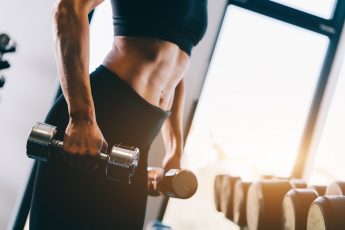
1. TIMEMANAGEMENT
NASM offers you 180 days to finish your CPT course and take the final exam. The timeline starts with your day of purchase. Don’t underestimate the amount you have to study! If you do not have a background in exercise science, make sure you allow plenty of time for studying. Studying human anatomy, the human movement system and how to design safe, effective and individualized exercise and conditioning programs contains a ton of information and you might feel overwhelmed with the amount of information. When I enrolled into the CPT program, NASM used the Fifth Edition of their book (which is included in all of the four programs) and has a total of 16 Chapters. Set weekly and monthly goals to help you stay focused and motivated and stick to your plan!
2. STRUCTURE
- Read
I read the whole chapter and highlighted in different colors important information. E.g. “Yellow” means general information and “Blue” means muscles and bones related science - Summary
After I read the chapter I went through it again and took handwritten notes for my own summary. Handwriting is just my personal preference and I feel like I retain information easier if I do it that way - Lecture videos
I watched every single lectures videos at least twice and saved the transcript - Activities
Personally I found the activities informative and fun at the same time. It was refreshing doing something besides reading, writing and watching. It was a perfect way to figure out what you’ve already learned and which areas you should re-study. - Chapter Quiz
At the end of each chapter you will find a quiz in your online section. Try to aim for at least 90% per quiz and chapter.
3. FLASHCARDS
Flashcards will become your new best friends. I used flashcards in the past and always found this method useful, but this is personal preference. The main content of my flashcards was the muscles (all of them are listed at the end of your book, Appendix D, including information like origin, insertion, isolated function and integrated function), important terms and phrases and the OPT-Model.
4. CONSISTENCY
Stick to your timetable and be consistent. You are doing this for yourself and your future, it is always worth spending more time on important things in life! If you don’t understand something, ask for help. Ask another Personal Trainer or reach out to NASM. But no matter what, stick to your plan, learn, repeat and read every single day.
5. NASM-CPT STUDY GUIDE
After I finished the online course and my book, I printed the NASM-CPT Study Guide and used it as a main source. The study-guide is a summary which was provided by NASM and is about 50 pages thin. The guide was divided into 6 primary domains with essential knowledge topics for the certification exam. After I felt comfortable with the knowledge I gained I started to practice the “120 questions master quiz” which I studied for hours on a daily basis, together with the Study guide and my personal notes.
6. IMPORTANT TOPICS
- Concepts and structures of anatomy including nervous system, muscular system, skeletal system, cardiorespiratory system and endocrine system will be one of the main parts in your exam. Learning the muscles names and location helped me later on understanding the idea of creating exercise and condition programs. It might be useful during your exam too if you struggle to answer a movement related question. I pictured the muscles and joints around the movement and was able to find my answer.
- Knowing postural imbalances and understanding the Overhead Squat Assessment will prepare you for over 10 questions on the NASM Exam. Think of the 3 main Postural Distortion Patterns of Upper Crossed, Lower Crossed and Pronation Distortion Syndrome. Know what muscles are overactive/underactive!
- The OPT-Model including the exercises – to be successful in the exercises portion of the test, it is important to be able to correlate what exercises belong to which Stage of Training: Stabilization, Strength or Power.
7. COMMON QUESTIONS
- Do I need to perform math during the exam, do I need to memorize the formulas from the book?
There is no math that you’ll need to do during the exam. The only formula you will need to know is the 208 – (0.7 x Age) to get the estimated maximum heart rate. - How many questions are on the NASM exam?
There are 120 questions on the NASM exam, 20 of which are for pre-trial research purposes and not scored – unfortunately you don’t know which are which - Are all of the questions multiple choice?
Yes! - Can I use a notepad during the NASM test?
No! You can’t use anything besides the computer. No pencil, no notebooks, no calculator, nothing. - When should I schedule my exam?
Again, this is personal preference but I scheduled it as soon as I could at the very end of the given timeline.
8. THE DAY BEFORE THE EXAM
- Pack your bag, double check if you have your CPR and AED certification, a valid ID and everything else you’ll need.
- Go to bed early, a good night sleep is important and keeps you calm the next day.
- Set several alarms, you don’t want to oversleep!
- Eat a light meal, don’t leave on an empty stomach.
- Arrive early! You have to check-in, show your ID including proof of a CPR and AED certification
- Take a deep breath and walk positive into the test room.
CONCLUSION
The harder you work for it the easier it will be at the end. I studied really hard for this exam and invested a significant amount of time into studying. At the end it was all worth, because I did it. I PASSED RIGHT AWAY!










Leave a Comment